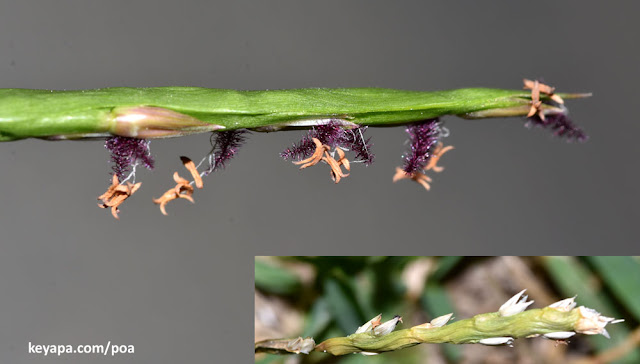 |
| Stenotaphrum secundatum (St. Augustine Grass) flowerhead with orange anthers and purple stigmas |
Notwithstanding the growing complaints about lawns, a lawn of turf grass has some aesthetic qualities. Lawns are clean looking to some people, and they project a sense of ordered structure that a mélange of different plants squeezed together might not.
 |
| Paspalum notatum (Bahiagrass) with purple anthers and stigmas |
But aside from a few weedy species like Poa annua that thwart the mower's blades by flowering close to the ground, the various turf grass species are kept from showing their full reproductive selves by the regular mowing that homeowners do. This incessant desire to keep the lawn grasses short prevents the grasses from pushing up flowerheads and scattering pollen and seeds to the winds, while making it difficult for homeowners to identify the grass from just their vegetative structures.
 |
| Zoysia matrella with tiny spikelike flowerheads |
Most turf grasses have relatively tiny inflorescences, a consequence of the fact grasses are wind-pollinated and have no need to expend energy on unneeded colorful petals and sepals. In addition, turf grasses are usually species which have evolved to be grazed, so they eschew tall stalks and flowerheads and keep close to the ground.
But it is still fascinating to see the usually colorful stigmas and anthers via some magnification, and by setting aside parts of the lawn as temporary no-mower areas, owners can finally see the turf grasses flower, as well as type them more accurately to species.
 |
| Eremochloa ophiuroides (centipede grass) with silvery stigmas and purple anthers |
So take some time to see what the flowers of your own lawn looks like. Make at least some part of your lawn no-mow until the tiny flowerheads and seedheads rise up to scatter your lawn's grass seeds to the wind.
No comments:
Post a Comment